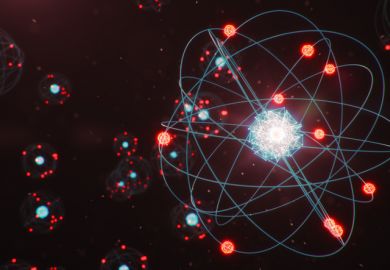Around the turn of the century, so legend has it, a newspaper tycoon wired a leading popular science writer: "Is there life on Mars? Cable 1000 words''. By return he got: "Nobody knows'', repeated 500 times. Today one could give him slightly more value for his money - say, 200 copies of "No - but there will be", The question of life in other worlds has fascinated mankind ever since it was realised that there were indeed other worlds, but until the dawn of the space age little meaningful could be said on the subject. As there seemed no possibility of resolving the question, millions of words of rubbish were generated to fill the resulting vacuum. This quotation from Percival Lowell, the inventor of the illusory Martian "canals", is typical: "That Mars is inhabited by beings of some sort or other we may consider as certain."
In the first golden age of space exploration of the 1970-80s, NASA's robot probes destroyed that naive certainty. Though the possibility of some indigenous life on Mars - even now, or in the remote past - cannot be completely ruled out, anything much above the bacterial level seems highly improbable. Perhaps in a reaction to what Carl Sagan has called "Lowell's Legacy'', some present-day astronomers have gone to the other extreme, arguing that not only is there no life elsewhere in this solar system - but that we may be alone in the entire universe! Whether one regards this reversion to pre-Copernican, earth-centered thinking as depressing or reassuring depends on one's philosophical outlook, but taking it too seriously seems a bad case of cosmic megalomania. Is it really possible that self-styled H. sapiens is the sole conscious creature in billions - no, trillions - of worlds? If so, this would surely merit at least one chapter in Douglas Adams's legendary Where God Went Wrong.
Paul Davies's slim book (exactly 100 pages) gives an excellent survey of the arguments that have raged around this subject for centuries. It is ironic that just when we have the technology that may answer this question, and NASA was preparing for the most detailed search of the cosmic radio spectrum ever made, Congress cancelled the whole project. Happily, the aptly-named Project Phoenix is now continuing with limited funds from private sources, so that the millions of dollars already spent by the US taxpayer will not be completely wasted. Even now, the 210-foot antenna at Parkes, New South Wales, is being used to scan 28 million radio channels per second, looking for signals which bear the hallmarks of intelligence.
Meanwhile, another alternative is being explored. A maverick English engineer, Stuart Kingsley, believes we have been looking at the wrong end of the electro-magnetic spectrum, and argues that quite small optical telescopes, of the type owned by thousands of amateurs, could detect light-pulses transmitted over interstellar distances. He has challenged the Microwave Mafia by setting up the world's first "Optical SETI" (Search for Extraterrestrial Intelligence) observatory. If his modest 10-inch reflector gets results before the acres of giant radio telescopes, it will be one of the most remarkable David versus Goliath episodes in the history of science.
Davies does not spend much time discussing such technical aspects, which are adequately covered in many other books. He is concerned with much more fundamental issues: for example, is life a random accident, or is the universe in some way designed to produce it? He explores some of the mind-boggling consequences of an infinite universe, in which everything that can happen will happen - an infinite number of times. This way, surely, lies madness. Most of us would prefer to believe that infinity does not exist except in pure mathematics, where it should be kept firmly in its place.
This summer the International Academy of Astronautics will be conducting a conference at Chamonix, France on "Cultural Aspects of SETI and the Implications for Society of the Discovery of Signals from Other Civilisations in the Galaxy''. The headings of the various sessions show how seriously - and in what detail - the whole subject is now taken: "Sociological and Psychological Sequelae of Detection", "Education and the Media", "Political, Ideological and Religious Considerations".
Unfortunately, many scientists and philosophers have been repelled by the blatant fraud and crackpottery which surrounds the whole subject. This is a great tragedy - because if genuine signals are ever detected, it may be very difficult to convince the establishment that they are not yet another hoax. Meanwhile, perhaps SETI should be given a few decades of benign neglect (except financially) to let serious researchers continue with their work in quietude, far from the madding media.
By an ironic coincidence, I had to interrupt the writing of this review to take part in a TV programme devoted to alien abductions, in which Esther Rantzen interviewed apparently sane and sincere individuals who claim to have had unusually traumatic encounters with visitors from outer space. All these accounts showed the same pathetic lack of imagination: the visitors were invariably humanoid.
But we are the product of millions of throws of the genetic dice; such a shuffling of the DNA molecules will seldom occur again in all eternity. The vast majority of real aliens will be as unlike us as the giant squid, the praying mantis, the termite colony. Many years ago, Loren Eisley in The Immense Journey summed up the situation in these eloquent words: "Nowhere in all space or on a thousand worlds will there be men to share our loneliness. There may be wisdom; there may be power; somewhere across space great instruments . . . may stare vainly at our floating cloud wrack, their owners yearning as we yearn. Nevertheless, in the nature of life and in the principles of evolution, we have had the answer. Of men elsewhere, there will be none forever.'' Arthur C. Clarke's collection of essays, The Colours of Infinity, will be published in the autumn.
Are We Alone? Philosophical Implications of the Discovery of Extraterrestrial Life
Author - Paul Davies
ISBN - 0 14 024585 5
Publisher - Penguin
Price - £5.99
Pages - 100



